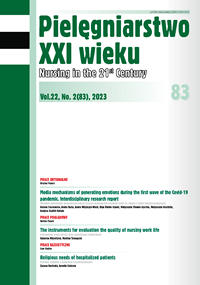Benefit of vaginal dilatational balloons in pregnancy
DOI:
https://doi.org/10.2478/pielxxiw-2023-0018Keywords:
childbirth, episiotomy, perineum rupture, vaginal dilatational balloon, incontinenceAbstract
BENEFIT OF VAGINAL DILATATIONAL BALLOONS IN PREGNANCY
Aim. Aim of research was to find out infl uence of using vaginal dilatational balloons in pregnancy on the origin birth injuries, leakage of urine after the childbirth. Apart from that, to investigate connection between using balloons in pregnancy and sexual difficulties after the childbirth.
Material and methods. The study contains 394 respondents, which used or did not use Aniball or Epi/no balloon in pregnancy and the time by their childbirth was minimum half of year. Quantitative research has been realized with the help of a non-standardized self constructed questionnaire. The research took place in gynecological clinics and through web browsers. Individual variables have been statistically tested with the help of Chi-square and Fisher’s test.
Results. By statistical research have we found out that there exist the connection between using vaginal dilatational balloons in pregnancy and the origin postnatal injury in the sense of their reduction. Women, who used vaginal dilatational balloon, have experienced a lower incidence of incontinence problems.
Conclusions. In empirical research we have found positive benefit of using vaginal balloons. Positive impact has been also found in connection with the origin postnatal injury and the development incontinence after the childbirth.
References
1. Howard D, Makhlouf M. Can pelvic floor dysfunction after vaginal birth be prevented. IUJ. 2016; 27(12): 1811-1815.
2. Bohatá P, Dostálek L. Antepartum options for preventing episiotomy and perineal rupture during childbirth. Czech gynecology. Prague: Czech Medical Society J.E. Purkyně. 2016; 81(3): 192-201.
3. Zanetti DRM, Petricelli DC, Alexandre MS, et al. Determination of a cutoff value for pelvic floor distensibility using the Epi-no balloon to predict perineal integrity in vaginal delivery. Sao Paulo Med. J. 2016; 134(2): 97-102.
4. Papadopoulou I. Increase in the efficiency of postpartum pelvic floor training using the EPINO trainer. TECSANA GmbH; 2020.
5. Hock M, Tardi P, Ambrus E, et al. Changes of pelvic floor muscle function during pregnancy. Studia Universitatis Babeş-Bolyai Educatio Artis Gymnasticae. 2019; 64(2): 57-68.
6. Shek KL, Dietz HP. Vaginal birth and Pelvic floor trauma. Curr. Obstet. Gynecol. Rep. 2019; 8(1): 15-25.
7. Němec M, Hořčička L, Krofta L, et al. Anatomy and biomechanics of the levator ani muscle. Czech gynecology. Prague: Czech Medical Society J.E. Purkyně. 2019; 84n(5): 393-397.
8. Vašek P, Gärtner M, Szabová O, et al. Urinary incontinence in pregnancy. Czech gynecology. Prague: Czech Medical Society J.E. Purkyně. 2019; 84(1): 73-76.
9. Freitas DeSS, Carbal LA, Pinto Costa MR, et al. Effects of perineal preparation techniques on tissue extensibility and muscle strength: a pilot study. IUJ. 2019; 30(6): 951-957.
10. Kamisan AI, Shek KL, Langer S, et al. Does the Epi-No birth trainer prevent vaginal birth-related pelvic floor trauma? A multicentre prospective randomised controlled trial. Internat. J. Gyneacol. Obstet. 2016; 123(6): 9951003.
11. Schreiner L, Crivelatti I, de Oliveira JM, et al. Systematic review of pelvic floor interventions during pregnancy. Int. J. Gynaecol. Obstet. 2018; 143(1):10-18.
12. Kubotani JS, Zanetti MRD, Araujo Júnior E, et al. Transperineal three-dimensional ultrasound for analyzing the effects of perineal stretching with EPI-NO® in women with multiple pregnancies: a pilot study. J. Matern Fetal. Neonatal. Med. 2022; 35(2): 283-290.
13. Chan SS, Cheung RYK, Yju KW, et al. Prevalence of urinary and fecal incontinence in Chinese women during and after their first pregnancy. IUJ. 2013; 24(9): 1473-1479.
14. Subki HA, Fakeeh MM, Hindi MM, et al. Fecal and Urinary Incontinence Associated with Pregnancy and Childbirth. Mater sociomed. 2019; 31(3): 202-206.
15. MacArthur C, Wislson D, Herbison P, et al. Urinary incontinence persisting after childbirth: extent, delivery history, and effects in a 12–year longitudinal cohort study. Internat. J. Gyneacol. Obstet. 2016; 123(6): 1022-1029.
16. Lawrence L, Rogers R, Borders N, et al. The effect of perineal lacerations on pelvic floor function and anatomy at six months postpartum in a prospective cohort of nulliparous women. Birth. 2016; 43(4): 293-309.
17. Quoc Huy NV, Phuc An LS, Phuong LS, Minh TL. Pelvic Floor and Sexual Dysfunction After Vaginal Birth With Episiotomy in Vietnamese Women. Sex Med. 2019; 7(4): 514-521.
Downloads
Published
Issue
Section
License
Copyright (c) 2023 Authors

This work is licensed under a Creative Commons Attribution 4.0 International License.




